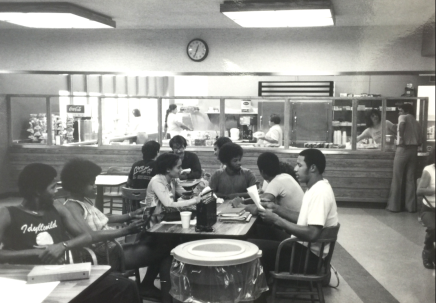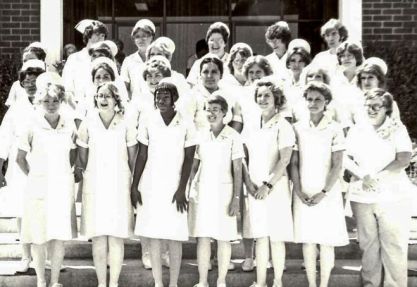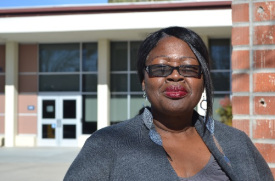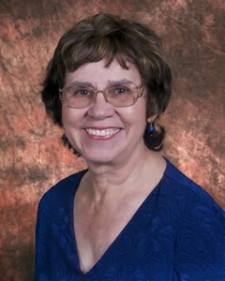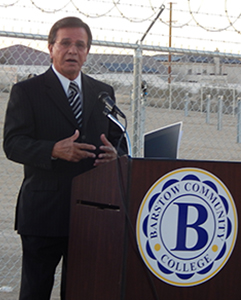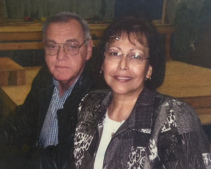The 1970s: Expansion and Identity
The decade of the 1970s was a time of expansion, construction and identity development for Barstow College. The community was invited to propose a variety of names for the new school; names like Mojave Desert College and High Desert College were offered. Community response was lackluster. It seemed the people of the region were satisfied with both the name of the school and the school itself. Finally, as a requirement of California law, the school’s name became Barstow Community College.
The campus added more buildings, enrollment held steady with one slight downturn early in the decade and all departments from academic to career training flourished. Early in the 1970’s, the school flirted with the quarter system and imposed it for a brief time. However, the college soon returned to the tried and true semester system. Unfortunately, due to California state budget cuts in the mid-1970’s and California Proposition 13, supported by voters in 1979, programs were reduced and many student clubs and sports vanished.
According to school records:
On April 14, 1970, regional voters approved a 40 cent override tax to assist the implementation of the school’s master building plan. Approximately 1,000 students were enrolled every semester since the school’s opening
Six buildings—business and science classroom complexes, library, gymnasium, campus center and maintenance—were included in the first increment of the master-planned campus. A technical building opened for classes in the fall of 1967. (Barstow College Catalog, 1970-71, 11)
College objectives included a continued learning environment supportive for students and the community of the Mojave Valley. The school continued its multi-pronged objectives of:
* General education—to provide a foundation for the full education of each individual so that he may achieve a broad understanding of the social and physical forces affecting his life and may become an effective member of his family, community and world society.
* Lower division university programs– to provide opportunities for students to complete requirements for transfer to a four-year college.
* Occupational education—to provide technical and vocational training to teach students new skills, expand existing skills or relearn vocations.
* Guidance—to provide students with necessary information. Counseling, and guidance to assist them in developing and progressing toward their goals.
* Community Services—to provide facilities and leadership for informal education, participation in a variety of activities so that the college may be a living social force and a cultural center for the community.
The college objectives included:
* Enabling all students to see their cultural heritage in its historical perspective
* Enabling students to live “effectively” with the conditions of the biological and physical environment.
* Enable students to recognize and guard the rights and responsibilities of citizenship in a free society.
* To guard and guide life by sound moral and spiritual values.
* To develop satisfactory relationships on all levels.
* To develop and implement critical thinking skills.
* To accept personal responsibility for decisions.
* To develop basic communication skills.
* To enjoy the benefits of successful careers and vocations.
* To appreciate and participate in creative activities.
The faculty stressed in the catalog that they hoped through education that Barstow students and graduates would make sound choices “rather than succumb to what may appear as overwhelming obstacles and acquire respect for the dignity of others.” (Catalog, 13)
An important program blossomed in the 1970s. Barstow College’s Vocational Nurses program offered training and career opportunities for dozens of students. The program was “open to males and females over 18 years of age who have completed at least the 10th grade…or can pass an equivalency test.” The coursework consisted of four day classes from 7:30 am- 4 pm and a class on “Hospital Day.” Nursing students wore special school uniforms while training at the hospital. The cost of books, uniforms and materials was about $135. Vocational Nursing Program Director Mary Kuhn explained that the training lasted about three semesters and then students graduate as qualified vocational nurses. (Dispatch, 7/33/76)
In looking back to the 1970s, long-time staffer Lesia Louro, a 40 year veteran of the college, explained that the era was a time for dreams and their fulfillment.” I am a dreamer and I like helping others achieve their dreams,” she explained. Louro joined the school staff in 1976 as a part-time records clerk. Within a year, she had advanced to a full-time position as school records clerk and international student records clerk.
“In those days, we had foreign exchange students from Jordan, Saudi Arabia, Ethiopia, Nigeria and India,” Louro explained. “We has students from the military, we had our Barstow residents. We were very busy.”
Eventually, Louro became an advisor specialist with the student success branch called EOPS. “We help students with support in several areas. We jell with their transfers….I like to think of EOPS as a ‘One-Stop Shop.'” she laughed. “We help students meet their academic needs and help direct them to funding to support costs of college fees. At one time, we even had a child care facility for students who were parents. Eventually, we sold that facility off… I love the people I serve, I love this college. I consider myself a dreamer into the future…I have a passion to help others with their education.”
Louro maintains that a key to college growth and student success was the “family atmosphere,’ that developed in the 1970’s. “We became like one big family,” Louro explained. “Administrators, staff and faculty worked together to ensure student success. We socialized together, we played sports together, and we joined in community activities, we had dinners, picnics and barbecues. We felt a common unity.”
Louro stressed that being a community college, everyone–school administrators, faculty and staff, must be in tune with community needs. “We are a community college. Our school offerings, programs and activities should be what the people want. We must go to the people to find their interests and needs. For example. We need to expand our adult education. Some people are embarrassed to go and get their GEDs at a high school. They would feel more comfortable coming to a college to get their high school credentials. We should bring the GED program back to the college.”
Louro explained that in the 1970’s and 1980’s, there were many more student clubs and college activities than today. “We had many school dances, we had clubs like MECHA [Mexican American student club]. The Black Student Union, we had the desert Safari tours, we had all kinds of sports teams. After California budget cuts and Prop. 13, we lost a lot. But things are beginning to come back around now and students are becoming more active again. The school is coming alive again.”
Louro explained that in the 1970s, there was very active community recruitment. “We would take a little trailer around the High Desert–to Yermo, to Daggett, to Irwin and around Barstow and invite people to sign up and register for the college,” she said. “We need to expand our outreach once again. We need to invite people to come and be a part of us…We must continue to dream. But we must do more than dream. Fulfillment of dreams requires action. We have a great school. We have momentum. We have the ability to be an even greater Barstow Community College.”
Another long-time Barstow college employee, Garland Dittman, a retired business professor, evaluated his 35 years at the school as, “the happiest years of my life. I loved every moment of it.” Dittman trained on Wall Street as a Merrill Lynch stock broker. After completing training and working for four years in Manhattan, he was assigned to the field office in Sacramento, California. He came to Barstow as Business and Career Placement Manager in 1971. “I am very, very proud of the 35 years I spent at Barstow College. I enjoyed the faculty and the administrators, especially Ted Baca and I loved working with the classified staff. “After a year or so, I was invited to teach business–I finally found my true calling in teaching.”
Dittman explained he loved the students and the employees. He said that teaching with the college led him to teach at many satellite locations. “I taught at the prison, I taught Marines at Yermo, soldiers at Ft. Irwin, airmen at George Air Force Base, even taught classes at Yellow Freight,” Dittman recalled. Dittman said he was pleased and surprised when Academic Dean Ted Baca asked him to be Division Chair of the Business Department and later the Math, Sciences and Health Divisions. ” I enjoyed working with Ted, he was an able administrator and a stand-up guy. We worked well together.” Dittman commented that one of the most important this he taught his business students was that managers should be good and responsible leaders and put their employees, their “people” first. “The people who work for you now may end up so successful that you end up working for them–so you better treat them right,” Dittman laughed.
Dittman explained that he hosted several parties for staff and faculty during his tenure at the college. ” I really enjoyed getting to know everyone. We had such wonderful people,” he said.
“I did a lot of community work. I worked with the community to save the Barstow Harvey House”, he said [entrepreneur Fred Harvey established guest houses and tourism facilities along the Santa Fe Railways in the Great Southwest and at the Grand Canyon in the later 19th and early 20th centuries. He was a key contributor to tourism in Arizona, New Mexico and California.] They were going to tear down the Harvey House in Barstow, but concerned community members who valued our Western history worked together to save it and help restore it.”
Another long-standing member of the Barstow Community College family is Class of 1962 graduate Mrs. Marcia Pierce. Mrs. Pierce completed her first two years of college at Barstow. She went on to earn her Bachelor’s degree in History and Political Science at the University of LaVerne. She earned a graduate degree in Education with an emphasis on Math and Science from Fresno Pacific University. In the 1970s, she travelled the world with her military husband. Upon return to Barstow, she taught grades Five-Eight and was instrumental in the reopening of the Desert Research Center at Hinkley, California. “My two sons and my husband all attended Barstow College,” Mrs Pierce explained. “I am dedicated to education and very proud of the college and my family.”
Mrs. Pierce became a college board trustee in 1999.”I am very pleased with the growth and the high academic standards of our college,” Mrs. Pierce explained. “From the very beginning, we have worked hard to ensure that we have the best possible school. We have dedicated faculty, dedicated staff and administrators and a board that strives to provide the best for our students and our community. It is sometimes a struggle, and I know some view our board as very conservative with money. But we do the best with what we have and we make sure our students are successful and that we involve our entire community.”
Someone with a truly unique and comprehensive perspective about the growth and development of Barstow Community College is Dr. Ted Baca. Dr. Baca has worn many hats during his years with the college. He served as a faculty member, went into college administration as a Division Chair and Executive Vice President of Instruction and Student Services. After retirement he served as an adjunct instructor and in 2005 was elected to the College Board of Trustees. He has served in that capacity since then. He offers remarkable insight into the development and growth of the school through many different lenses.
Dr. Baca is from an old and respected Barstow family, whose ancestors came from New Mexico and Spain. He graduated from Barstow High School, received a Bachelor’s Degree in biology and physical education from New Mexico Highlands University and a Master’s of Science in Biology from the same university. He received support for his doctoral studies at the University of Oregon through a National Institute of Health Teaching Fellowship. After completing his formal education, Dr. Baca returned to Barstow and accepted a faculty appointment in athletics and physical health in 1977.
“I originally came here as an assistant football coach and instructor in health education, “Baca explained. “But ultimately, I ended up teaching many subjects: health, anatomy, physiology, zoology, general biology.” Baca explained that he enjoyed teaching but accepted administrative appointments including Executive Vice President of Instruction and Student Services.
“While a vice president, I received a Ford Foundation fellowship to study successful community colleges and their philosophies across the United States,” Baca explained. “It was interesting—we went to campuses like the Maricopa campuses in Arizona and the Miami Dade campuses. In addition to learning from outstanding education administrators, I got to meet other community college leaders from throughout the country. It was quite an experience and I learned a lot.”
Baca commented that while he enjoyed administrative duties, the appointment of Vice President of Academic and Student Services, “is a very big job. You cannot do that job for too very long… It is very difficult to manage…Besides, you do not get to interact much with students and when you do, it usually involves a disciplinary situation.”
Baca explained that he enjoyed teaching and made the decision to return to the classroom after years in administration. “I prefer working with students. So, I moved back into the classroom. I continued teaching until retirement, I especially enjoyed working with the nursing students. Nursing is a respected and honorable profession and I was happy to help the students. Teaching is wonderful. I loved it.”
Baca said he “stayed around” the college as an adjunct for a while and “then one of the board members gave notice that he was going to leave in the middle of his term. It was an election year. So I said, ‘okay,’ I’ll run. If I like it, I’ll stay. If I don’t, I’ll leave. After all, it’s only two years.”
Baca won the election. He explained that serving on the board was much like being an administrator, only with bigger responsibilities. “I look at my role as a board member as being a steward of community resources,” Baca said. “My major concern then was that I related my experience, my judgement, my thinking, my philosophy to the best interests of the community at large, not to only one individual of one special interest group.”
Baca explained that his myriad of experiences from faculty to administrator to board member contributed to a deep breadth of knowledge in board decision making. “I have been on the faculty side of the aisle. I have been on the administrative side of the aisle. I don’t know which side of the aisle the board is on…But I have been there, too. I have seen the issues from varied perspectives and I think it helps me with decisions and leadership.”
Baca noted that the school has faced many challenges through the years. “When I first came on as an administrator, we were like….broke,” Baca laughed. “We had no money. So we had to do a lot of creative things and find a lot of ways to sustain programs and meet student needs and tend to faculty….It was a challenge. It was a real challenge.”
Baca commented that over time and with careful decision making and planning, “We arrived at some fiscal stability and we were able to sustain our position and even beyond. We developed prudent, responsible budgets and have arrived at the campus as it is today. It is good and it will get better,” Baca explained.
Baca said as the college “evolved” it rose to meet the needs of academic students, career and vocational training and the general community. “I want to see continued academic and transfer growth, but in these times when so much is changing and so much is falling apart, good career training and vocational programs must expand as well.”
Baca pointed out that community colleges must reach out and determine the community needs. “Many people need to upgrade their skills or get career training to get out there and support themselves and their families,” he stressed. “Not everyone needs a college degree.”
Baca mentioned that he would like to see the Career Training campus relocated from its current State Street location to the BCC main campus. “Look, we spend a lot of money in rent. We spend a lot of money making improvements out there. So, let’s work to get together some funding locally and through the county and state and get a building up here. That is sound fiscal planning.”
Baca said every board needs vision, planning and sound fiscal management. “We had the vision to bring solar to our campus. Now, we need to start taking steps and planning for thirty years into the future for the college.”
As an example, Baca pointed out that he counted “some 17 water catchments throughout the main campus. Some of them are right at the front entrance. This may have been fine for past needs, but these catchments are taking up valuable land that could be used for classrooms and buildings. We are no longer an ‘80s campus. We need to start budgeting and saving for the future—we will need to put that land to use. Besides, it is an aesthetic problem, too,” he laughed.
Baca concluded that the biggest success of the college has been its ability to “adapt and evolve,” to meet the needs of the community. “I am proud of this college and I am proud of what we have accomplished. We are building toward the future, It may take a decade to save the resources to make the needed changes—but we will get there, Well, let’s see what happens.”
Longtime college employee & union steward of CSEA, union representative Mr. William King & wife Della King. King started as a custodian in 1970 and retired as Head of maintenance in 2003 after 33 years of service.
Barstow College and Ft. Irwin
In 1970, Congress closed several military bases throughout the United States. Ft. Irwin, some 40 miles north of Barstow, was one of those installations. Mojave River Valley and Barstow residents were deeply concerned about the economic impact of such closures in the region. On July 7, 1970, federal officials from six government agencies met with concerned community leaders. Expressing concerns about an economic downturn, the locals demanded federal support in the event of Ft. Irwin’s closure.
Federal officials pledged that money grants for Barstow would “get a high priority in a government move to take the sting from the impending inactivation of Ft. Irwin.” (Dispatch, 1970)
Federal officials pledged that Barstow would receive “individualized Washington assistance [in] attracting new industry to the area.” Heading the federal delegation was the Department of Defense economic Development Director Donald Bradford.
Bradford said that the team was “particularly impressed with two things that would attract developers to Barstow: Barstow Community College with a technical/vocational program already in operation and capable of expansion… and the Barstow-Daggett Airport.” (Dispatch, 1970)
In January 1971, Ft. Irwin was deactivated and placed on maintenance status. When the post closed, the class offerings to soldiers ended as well. The National Guard used Ft. Irwin as a training base through 1980. By then, the Department of the Army had announced that Ft. Irwin was selected as the home of the new National Training Center. Ft. Irwin was reactivated on October 16, 1980 and restored to full operational status on July 1, 1981. Barstow College resumed its teaching relationship with the Fort and has retained it ever since.
1970’s Accomplishments
The key accomplishments of Barstow Community College in the 1970’s decade were: Development of a strong college identity, continuation of fine academic, transfer, certificate and vocational programs and incorporation of an outstanding nursing program. The school became recognized as a viable community college.
In addition to outstanding programs, the college developed excellent athletic teams. For a small desert college, they excelled in local and regional competition. Unfortunately, due to state budget cuts, teams like the football griders and other sports were eliminated.
California Academia faced serious threats by the end of the decade, due to elimination of strong tax support as a result of California Proposition 13. Despite the blows, Barstow Community College engaged in creative planning and continued building and excelling. The fact that the school survived and even expanded in student numbers and pursued its Master Building plan is a testimony to the tenaciousness of the desert campus.

